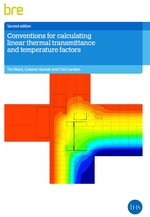Conventions for calculating linear thermal transmittance and temperature factors
BRE is an independent, research-based consultancy, testing and training organisation, operating in the built environment and associated industries.
On 3 June 2016, BRE published Conventions for calculating linear thermal transmittance and temperature factors (BR 497 2nd edition), written by Tim Ward, Graeme Hannah and Chris Sanders.
Well-insulated buildings require sophisticated techniques to model heat loss caused by thermal bridging at wall, roof and floor junctions and around openings. Thermal bridging at these junctions can add significantly to fabric heat loss and cause localised reduction in internal surface temperatures, which can lead to surface condensation and mould problems. A more detailed calculation method for U-values, as defined in BS EN ISO 6946:2007, has been introduced to take account of these repeating thermal bridges.
The BRE guide provides the information needed to carry out these calculations so that different users of the same software package or users of different software packages can obtain consistent and reproducible results. It is intended for use by designers and numerical modellers.
For building regulation purposes two key modelling outputs are identified:
These outputs enable designers to assess junction details and develop novel solutions to improve thermal performance.
The second edition of the guide has been updated to include additional junction types and information about how they should be modelled, as well as worked examples giving the determined values of linear thermal transmittance and temperature factors.
The contents of the guide are:
- Introduction.
- Numerical modelling.
- Thermal bridging at junctions.
- Junction types.
- Point thermal bridges, chi-values.
- Reporting of calculations.
- References.
- Appendix A: Detailed Input and Output from a numerical model.
- Appendix B: Worked examples with calculated values of psi and f.
[edit] Find out more
[edit] Related articles on Designing Buildings Wiki
- Air tightness in buildings.
- Cavity wall insulation.
- Computational fluid dynamics.
- Computational fluid dynamics in building design: An introduction FB 69.
- Conventions for U-value calculations (2006 edition) BR 443.
- Floor insulation.
- g-value.
- k-value.
- Heat transfer.
- Insulation specification.
- Limiting fabric parameters.
- Roof insulation.
- Solid wall insulation.
- Standard Assessment Procedure SAP.
- Thermal admittance.
- Thermal bridge.
- Thermal mass.
- Thermographic survey.
- U value.
- U-value conventions in practice: Worked examples using BR 443.
Featured articles and news
Infrastructure that connect the physical and digital domains.
Harnessing robotics and AI in challenging environments
The key to nuclear decommissioning and fusion engineering.
BSRIA announces Lisa Ashworth as new CEO
Tasked with furthering BSRIA’s impressive growth ambitions.
Public buildings get half a million energy efficiency boost
£557 million to switch to cleaner heating and save on energy.
CIOB launches pre-election manifesto
Outlining potential future policies for the next government.
Grenfell Tower Inquiry announcement
Phase 2 hearings come to a close and the final report due in September.
Progress from Parts L, F and O: A whitepaper, one year on.
A replicated study to understand the opinion of practitioners.
ECA announces new president 2024
Electrical engineer and business leader Stuart Smith.
A distinct type of countryside that should be celebrated.
Should Part O be extended to existing buildings?
EAC brands heatwave adaptation a missed opportunity.
Definition of Statutory in workplace and facilities management
Established by IWFM, BESA, CIBSE and BSRIA.
Tackling the transition from traditional heating systems
59% lack the necessary information and confidence to switch.
The general election and the construction industry
As PM, Rishi Sunak announces July 4 date for an election.
Eco apprenticeships continue help grow green workforce
A year after being recognised at the King's coronation.
Permitted development rights for agricultural buildings
The changes coming into effect as of May 21, 2024.























